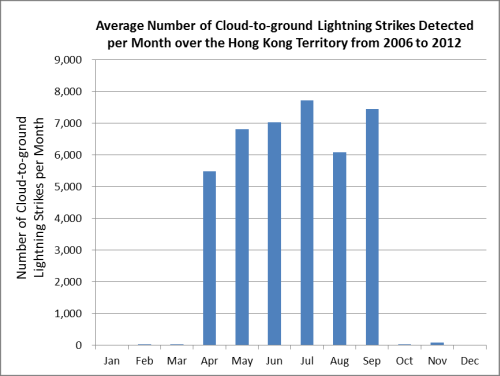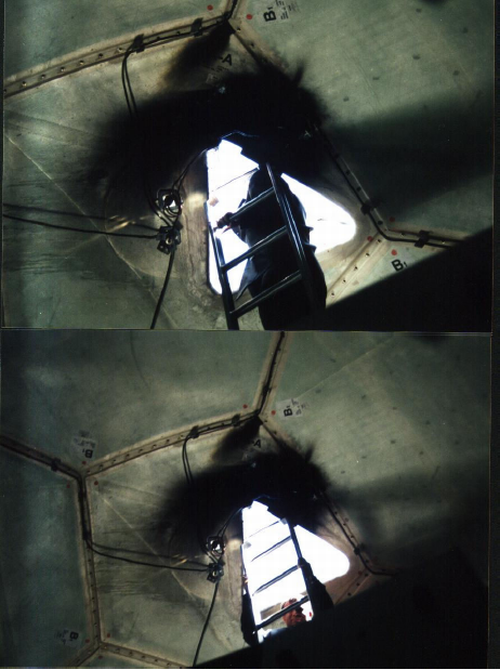Extraordinary Lightning Protection System for Weather Radar Stations
Extraordinary Lightning Protection System for Weather Radar Stations
KONG Wai
June 2013
Thunderstorm is a common weather phenomenon during rainy season in Hong Kong. From April to September each year, thunderstorms may occur frequently. Figure 1 shows the monthly average numbers of cloud-to-ground lightning strikes over Hong Kong in April to September from 2006 to 2012 and all of them exceeded five thousand. To protect buildings from lightning strikes, a good lightning protection system is essential. A brief account of lightning protection theory is described in the article "Don't be a lightning rod" on HKO Educational Resources webpage[1]. In simple terms, a lightning rod will attract nearby electric charges and lead the current to the ground through an earthing device for protecting the building against lightning strikes. The electrical resistance of the earthing device, called lightning earthing resistance, is a crucial parameter determining effectiveness of the lightning protection system. The lower the lightning earthing resistance is, the more efficient it will conduct electric current and the lightning protection will perform better.

Figure 1 Average number of cloud-to-ground lightning strikes detected per month over the Hong Kong Territory from 2006 to 2012
General Specification for Electrical Installation in Government Buildings of the Hong Kong Special Administrative Region[1] published by the Architectural Services Department states that lightning earthing resistance shall not exceed 10 ohms for ordinary government buildings. This requirement is not applicable to the protection of overhead power lines and other specialized buildings which have their own requirements. The Observatorys weather radar stations are among such specialized buildings which have to comply with more stringent standard due to the following reasons.
Mission critical
Weather radar is a primary tool for monitoring severe weather including rainstorms and typhoons and is indispensable for weather forecasting. A weather radar must operate in all weather for safeguarding the life and property of members of the public. During thunderstorms, it is the time when the weather radar is needed most and its normal operation must be guaranteed.
Geographical location
Weather radar station usually stands head-and-shoulders above the surroundings to have an unobstructed view of the sky for weather monitoring. For example, the Tai Mo Shan weather radar station sits on the top of Tai Mo Shan, the highest peak in Hong Kong. Such locations are particularly susceptible to lightning strikes. Moreover, weather radars contain sophisticated electronic equipment which are vulnerable to the surge of unstable electrical current induced by lightning. Thus, a more stringent standard on lightning earthing resistance is required for weather radar stations for safeguarding against lightning strikes.
The Observatory adopts a stringent requirement of lightning earthing resistance not exceeding one ohm for weather radar stations in order to reduce the risk of lightning strikes. Such standard for weather radar stations is also required by the international community, as exemplified in the report "Instruments and Observing Report No. 88 (IOM-88) of the World Meteorological Organization (WMO)"[2] published by Commission for Instruments and Methods of Observations (CIMO) of WMO. Figure 2 is extracted from IOM-88 which shows a burned radar radome after hit by lightning strikes in radar station overseas. In the mid-90s of the last century, experts from USA and Australia advising the Observatory on construction of the Tai Lam Chung Terminal Doppler Weather Radar Station also pointed out that lightning earthing resistance of the radar station must not exceed one ohm.

Figure 2 Burned radar radome after hit by lightning strikes in radar station overseas(Extracted from: CIMO Report IOM-88)[3]
A lightning earthing resistance of not more than one ohm can protect a weather radar station from lightning strikes, ensuring normal operation of the radar which is essential to the provision of weather information services to the public in inclement weather.
References:
[1] HKO Educational Resources Article - "Don't be a lightning rod".
[2] General Specification for Electrical Installation in Government Buildings of the Hong Kong Special Administrative Region.
[3] Commission for Instruments and Methods of Observations (CIMO) Report IOM-88.
[1] HKO Educational Resources Article - "Don't be a lightning rod".
[2] General Specification for Electrical Installation in Government Buildings of the Hong Kong Special Administrative Region.
[3] Commission for Instruments and Methods of Observations (CIMO) Report IOM-88.